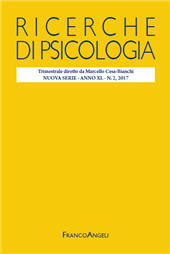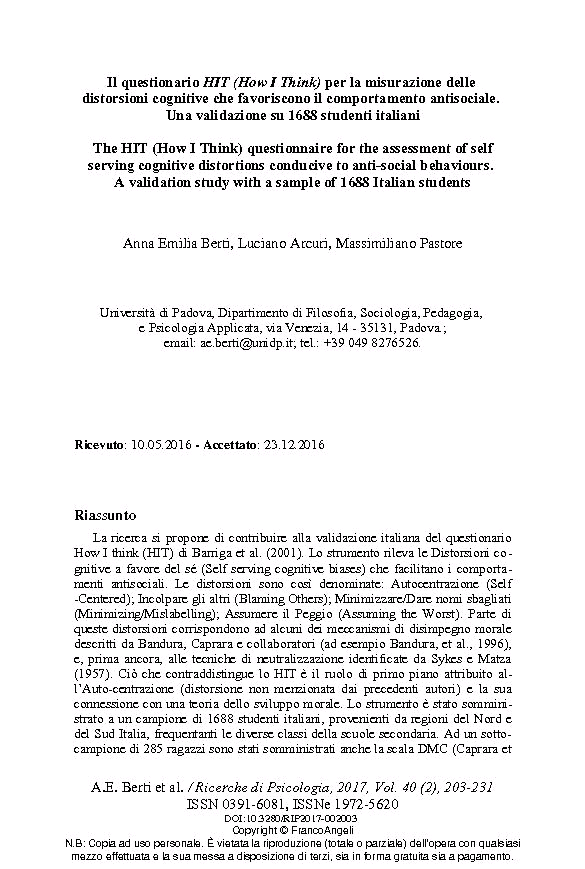Il questionario HIT (How I Think) per la misurazione delle distorsioni cognitive che favoriscono il comportamento antisociale : una validazione su 1688 studenti italiani
203-231 p.
La ricerca si propone di contribuire alla validazione italiana del questionario How I think (HIT) di Barriga et al. (2001). Lo strumento rileva le Distorsioni co-gnitive a favore del sé (Self serving cognitive biases) che facilitano i comporta-menti antisociali. Le distorsioni sono così denominate: Autocentrazione (Self -Centered); Incolpare gli altri (Blaming Others); Minimizzare/Dare nomi sbagliati (Minimizing/Mislabelling); Assumere il Peggio (Assuming the Worst). Parte di queste distorsioni corrispondono ad alcuni dei meccanismi di disimpegno morale descritti da Bandura, Caprara e collaboratori (ad esempio Bandura, et al., 1996), e, prima ancora, alle tecniche di neutralizzazione identificate da Sykes e Matza (1957).
Ciò che contraddistingue lo HIT è il ruolo di primo piano attribuito all'Auto-centrazione (distorsione non menzionata dai precedenti autori) e la sua connessione con una teoria dello sviluppo morale. Lo strumento è stato sommini-strato a un campione di 1688 studenti italiani, provenienti da regioni del Nord e del Sud Italia, frequentanti le diverse classi della scuole secondaria. Ad un sotto-campione di 285 ragazzi sono stati somministrati anche la scala DMC (Caprara et al., 2006) e il questionario sui valori di Schwartz (1992). Ad un sotto-campione di 587 ragazzi, di I, III, e V sono state somministrate la scala sulla disapprovazione della devianza e quella sulla devianza dichiarata, contenute nel questionario "Io e la mia salute" (Bonino et al., 2003). L'analisi fattoriale confermativa ha identificato i fattori corrispondenti alle quattro distorsioni.
La validità convergente dello strumento è stata confermata dalle elevate correlazioni positive tra i punteggi fattoriali corrispondenti alle quattro distorsioni cognitive e lo DMC (0,68 < r < 0,70) i comportamenti devianti dichiarati (0,58 < r < 0,59) e dalla correlazione negativa con la disapprovazione dei comportamenti devianti (-0,58 < r < -0,68). Per quanto riguarda i valori, sono emerse correlazioni positive con potere (0,35 < r < 0,40), edonismo (0,28 < r < 0,31) stimolazione (0,27 < r < 0,31) e successo (0,15 < r < 0,17) e negative con benevolenza (-0,18 < r < -0,20) e universalismo (tutti gli r = -0,20), conformismo (-0,21 < r < -0,28) e spiritualità (-0,16 < r < -0,17). Un'interessante relazione curvilinea tra l'età dei partecipanti e le prestazioni nelle diverse scale dei comportamenti antisociali viene infine descritta e interpretata. [Testo dell'editore].
The present study aims to contribute to the Italian validation of the How I think questionnaire (HIT) (Barriga et al., 2001). The questionnaire is designed to assess four Self serving cognitive distortions contributing to anti-social behav-iours: Self-Centered, Blaming Others, Minimizing /Mislabelling, Assuming the Worst. Some of these distortions have characteristics in common with some of the Mechanisms of moral disengagement described by Bandura, Caprara and co-workers (e.g.: Bandura et al., 1996) and with the Techniques of neutralization identified by Sykes and Matza (1957) even before. What characterizes HIT is its link to a theory of moral development and the central role assigned to Self-Centered (a distortion not mentioned by previous authors).
Participants were 1688 secondary school students from Northern and Southern Italy (F = 45%), attending 9th-to-13th grades. A sub-sample of 285 students also completed the DMC questionnaire (Caprara et al., 2006) and Schwartz (1992) Value Survey. A sub-sample of 587 students from 9th, 11th and 13th grades also completed the scales of self-reported deviant behaviour and deviant behaviour disapproval from Jessor Health Behaviour Questionnaire (Jessor et al., 1992). Confirmatory factor analyses highlighted factors matching the four cognitive distortions.
Convergent validity of the instrument was confirmed by significant positive correlations between cognitive distortions factorial scores and DMC (.68 < rs < .70) and self-reported deviant behaviours (.58 < rs < .59), and by the significant negative correlation with disapproval of deviant behaviours (-.58 < rs < -.68). A coherent pattern of correlations with values also emerged. We found positive correlations with power (.35 < rs < .40), hedonism (.28 < rs < .31), stimulation (.27 < rs < .31) and achievement (.15 < rs < .17) and negative correlations with benevolence (-.18 < rs < -.20), universalism (all rs = .20) and conformity (-.21 < rs < -.28) and spirituality (-.16 < rs < -.17). Lastly, an interesting curvilinear relation between age and scores of cognitive distortions is described and tentatively explained. [Publisher's Text].
Is part of
Ricerche di psicologia : 2, 2017-
Articles from the same issue (available individually)
-
Information
ISSN: 1972-5620
DISCIPLINES
KEYWORDS
- Validazione questionario, distorsioni cognitive al servizio del sé, comportamento antisociale, studenti secondaria di secondo grado, analisi fattoriale confermativa
- Questionnaire validation, self-serving cognitive distorsions, anti-social behaviour, secondary school students, confirmatory factor analysis



